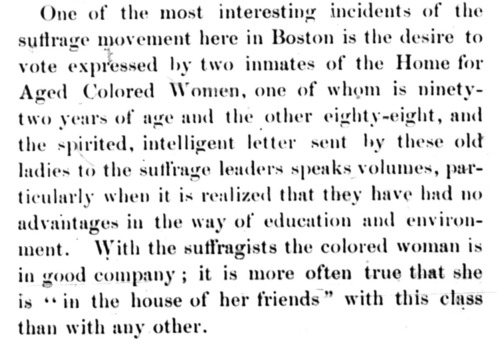Last updated: January 8, 2023
Place
Site of the Home for Aged Colored Women

NPS Photo/Woods
The Home for Aged Colored Women served as the first home for elderly Black women in the city. Rebecca Parker Clarke, the mother of Rev. James Freeman Clarke, enlisted the help of White and Black community leaders to found this home including Reverend Leonard Grimes, future Massachusetts Governor John Andrew, and others. After a fundraising campaign in 1860, the newly established organization rented a house at 65 Southac Street (now Phillips Street).1
As rooms filled, the Home began looking for other accommodations. It moved to this site at 27 Myrtle Street in 1864, remaining in this location for over three decades. In 1900, the Home spent its final years at 22 Hancock Street, the site of Charles Sumner's house.2
Many of its residents came from within the Black community on Beacon Hill, being recommended through word of mouth. Many belonged to one of the predominantly Black churches in the neighborhood, such as Twelfth Baptist Church, the First African Baptist Church (now the African Meeting House), A.M.E. Zion Church, or Charles Street A.M.E. Church.3 The Home's location allowed for a continued relationship between the community and residents of the home, and the community supported this home throughout its existence.
Residents of the Home for Aged Colored Women maintained an interest in community work and social activism. The Woman's Era wrote of two residents of the Home, in their eighties and nineties, who sent a "spirited, intelligent letter" supporting women's suffrage to prominent suffragists. While neither the original letter, nor the names of the women who wrote it, have been located, its mere existence provides insight on the interest of women's suffrage throughout Boston's Black community.4

Clipping from The Woman's Era on interest in suffrage at the Home for Aged Colored Women. (Credit: "Colored Women and Suffrage" in the Woman's Era Vol. 2, no. 7, November 1895.)
Footnotes:
- Kathryn Grover and Janine da Silva, “Historic Resource Study: Boston African American National Historic Site” (December 31, 2002); Sarah J. Shoenfeld, “Applications and Admissions to the Home for Aged Colored Women in Boston, 1860-1887,” New England Historical and Genealogical Register 155 (July 2001): 251-272; 155 (October 2001): 397-413; 156 (January 2002): 62-85.
- Kathryn Grover and Janine da Silva, “Historic Resource Study: Boston African American National Historic Site” (December 31, 2002); Sarah J. Shoenfeld, “Applications and Admissions to the Home for Aged Colored Women in Boston, 1860-1887,” New England Historical and Genealogical Register 155 (July 2001): 251-272; 155 (October 2001): 397-413; 156 (January 2002): 62-85.
- Sarah J. Shoenfeld, “Applications and Admissions to the Home for Aged Colored Women in Boston, 1860-1887,” New England Historical and Genealogical Register 155 (July 2001): 251-272; 155 (October 2001): 397-413; 156 (January 2002): 62-85.
- "Colored Women and Suffrage," The Woman's Era 2, no. 7, (November 1895).
